Financial Performance Management Report: Issues and Tools
VerifiedAdded on 2023/01/04
|9
|3286
|89
Report
AI Summary
This report delves into financial performance management, emphasizing the critical issues businesses face in managing environmental costs and the accounting methods employed. It explores the significance of environmental management accounting in analyzing, monitoring, and controlling data related to energy, water, and material usage, including associated costs. The report details various environmental costs, such as product output, waste, and emission control, alongside the cost-benefit analysis used to evaluate business decisions. It also outlines techniques like input/output analysis, flow cost accounting, and activity-based costing. Furthermore, the report discusses how businesses incorporate management accounting planning tools, including final accounts and management accounting reports, to solve financial problems. Key planning tools like capital budgeting are also examined to highlight their role in financial decision-making. The report underscores the importance of effective decision-making in achieving business objectives and ensuring systematic operational activities. It also emphasizes the use of financial statements (profit and loss account, balance sheet, and cash flow statement) for evaluating a company's financial position.

Financial Performance
Management
Management
Paraphrase This Document
Need a fresh take? Get an instant paraphrase of this document with our AI Paraphraser
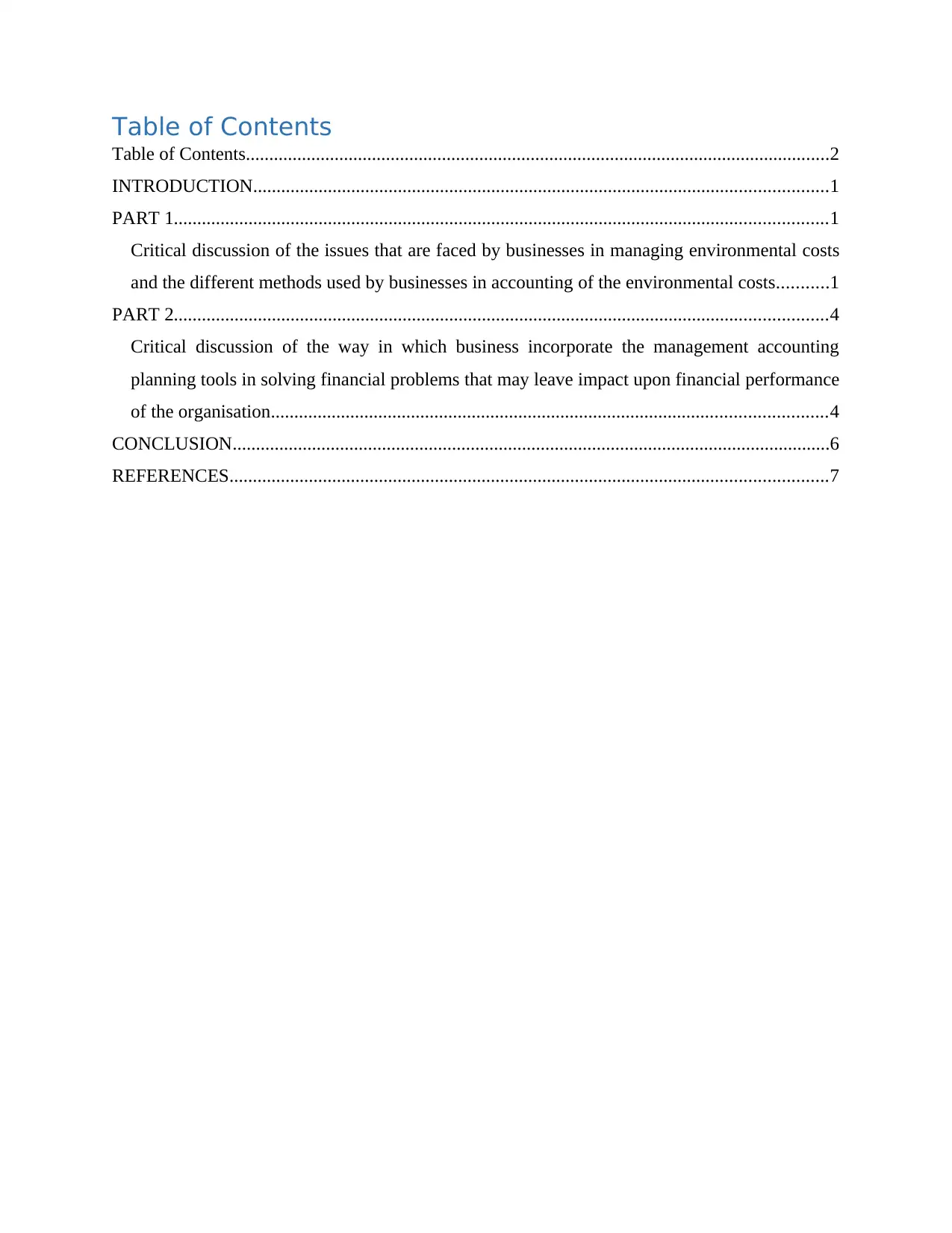
Table of Contents
Table of Contents.............................................................................................................................2
INTRODUCTION...........................................................................................................................1
PART 1............................................................................................................................................1
Critical discussion of the issues that are faced by businesses in managing environmental costs
and the different methods used by businesses in accounting of the environmental costs...........1
PART 2............................................................................................................................................4
Critical discussion of the way in which business incorporate the management accounting
planning tools in solving financial problems that may leave impact upon financial performance
of the organisation.......................................................................................................................4
CONCLUSION................................................................................................................................6
REFERENCES................................................................................................................................7
Table of Contents.............................................................................................................................2
INTRODUCTION...........................................................................................................................1
PART 1............................................................................................................................................1
Critical discussion of the issues that are faced by businesses in managing environmental costs
and the different methods used by businesses in accounting of the environmental costs...........1
PART 2............................................................................................................................................4
Critical discussion of the way in which business incorporate the management accounting
planning tools in solving financial problems that may leave impact upon financial performance
of the organisation.......................................................................................................................4
CONCLUSION................................................................................................................................6
REFERENCES................................................................................................................................7
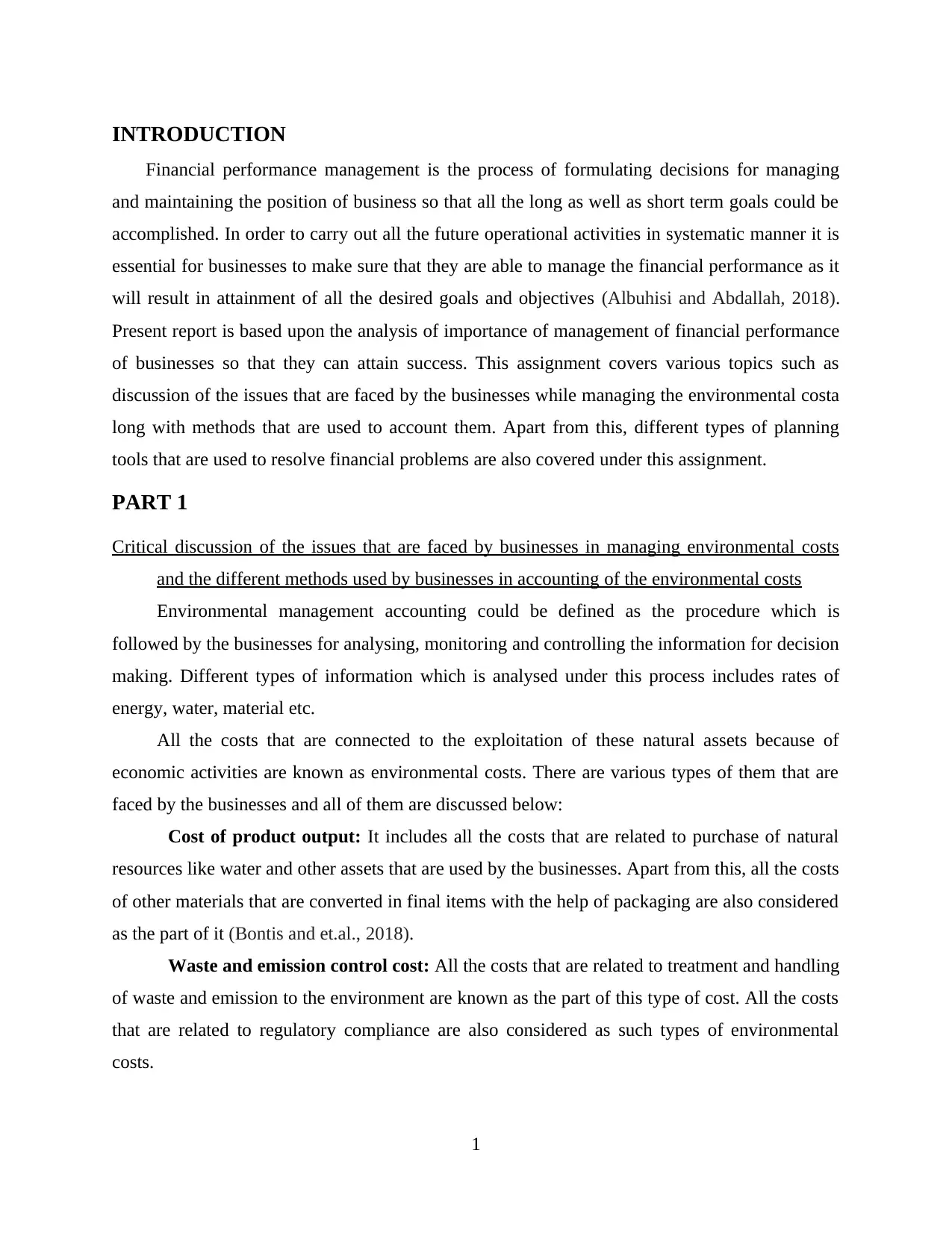
INTRODUCTION
Financial performance management is the process of formulating decisions for managing
and maintaining the position of business so that all the long as well as short term goals could be
accomplished. In order to carry out all the future operational activities in systematic manner it is
essential for businesses to make sure that they are able to manage the financial performance as it
will result in attainment of all the desired goals and objectives (Albuhisi and Abdallah, 2018).
Present report is based upon the analysis of importance of management of financial performance
of businesses so that they can attain success. This assignment covers various topics such as
discussion of the issues that are faced by the businesses while managing the environmental costa
long with methods that are used to account them. Apart from this, different types of planning
tools that are used to resolve financial problems are also covered under this assignment.
PART 1
Critical discussion of the issues that are faced by businesses in managing environmental costs
and the different methods used by businesses in accounting of the environmental costs
Environmental management accounting could be defined as the procedure which is
followed by the businesses for analysing, monitoring and controlling the information for decision
making. Different types of information which is analysed under this process includes rates of
energy, water, material etc.
All the costs that are connected to the exploitation of these natural assets because of
economic activities are known as environmental costs. There are various types of them that are
faced by the businesses and all of them are discussed below:
Cost of product output: It includes all the costs that are related to purchase of natural
resources like water and other assets that are used by the businesses. Apart from this, all the costs
of other materials that are converted in final items with the help of packaging are also considered
as the part of it (Bontis and et.al., 2018).
Waste and emission control cost: All the costs that are related to treatment and handling
of waste and emission to the environment are known as the part of this type of cost. All the costs
that are related to regulatory compliance are also considered as such types of environmental
costs.
1
Financial performance management is the process of formulating decisions for managing
and maintaining the position of business so that all the long as well as short term goals could be
accomplished. In order to carry out all the future operational activities in systematic manner it is
essential for businesses to make sure that they are able to manage the financial performance as it
will result in attainment of all the desired goals and objectives (Albuhisi and Abdallah, 2018).
Present report is based upon the analysis of importance of management of financial performance
of businesses so that they can attain success. This assignment covers various topics such as
discussion of the issues that are faced by the businesses while managing the environmental costa
long with methods that are used to account them. Apart from this, different types of planning
tools that are used to resolve financial problems are also covered under this assignment.
PART 1
Critical discussion of the issues that are faced by businesses in managing environmental costs
and the different methods used by businesses in accounting of the environmental costs
Environmental management accounting could be defined as the procedure which is
followed by the businesses for analysing, monitoring and controlling the information for decision
making. Different types of information which is analysed under this process includes rates of
energy, water, material etc.
All the costs that are connected to the exploitation of these natural assets because of
economic activities are known as environmental costs. There are various types of them that are
faced by the businesses and all of them are discussed below:
Cost of product output: It includes all the costs that are related to purchase of natural
resources like water and other assets that are used by the businesses. Apart from this, all the costs
of other materials that are converted in final items with the help of packaging are also considered
as the part of it (Bontis and et.al., 2018).
Waste and emission control cost: All the costs that are related to treatment and handling
of waste and emission to the environment are known as the part of this type of cost. All the costs
that are related to regulatory compliance are also considered as such types of environmental
costs.
1
⊘ This is a preview!⊘
Do you want full access?
Subscribe today to unlock all pages.

Trusted by 1+ million students worldwide
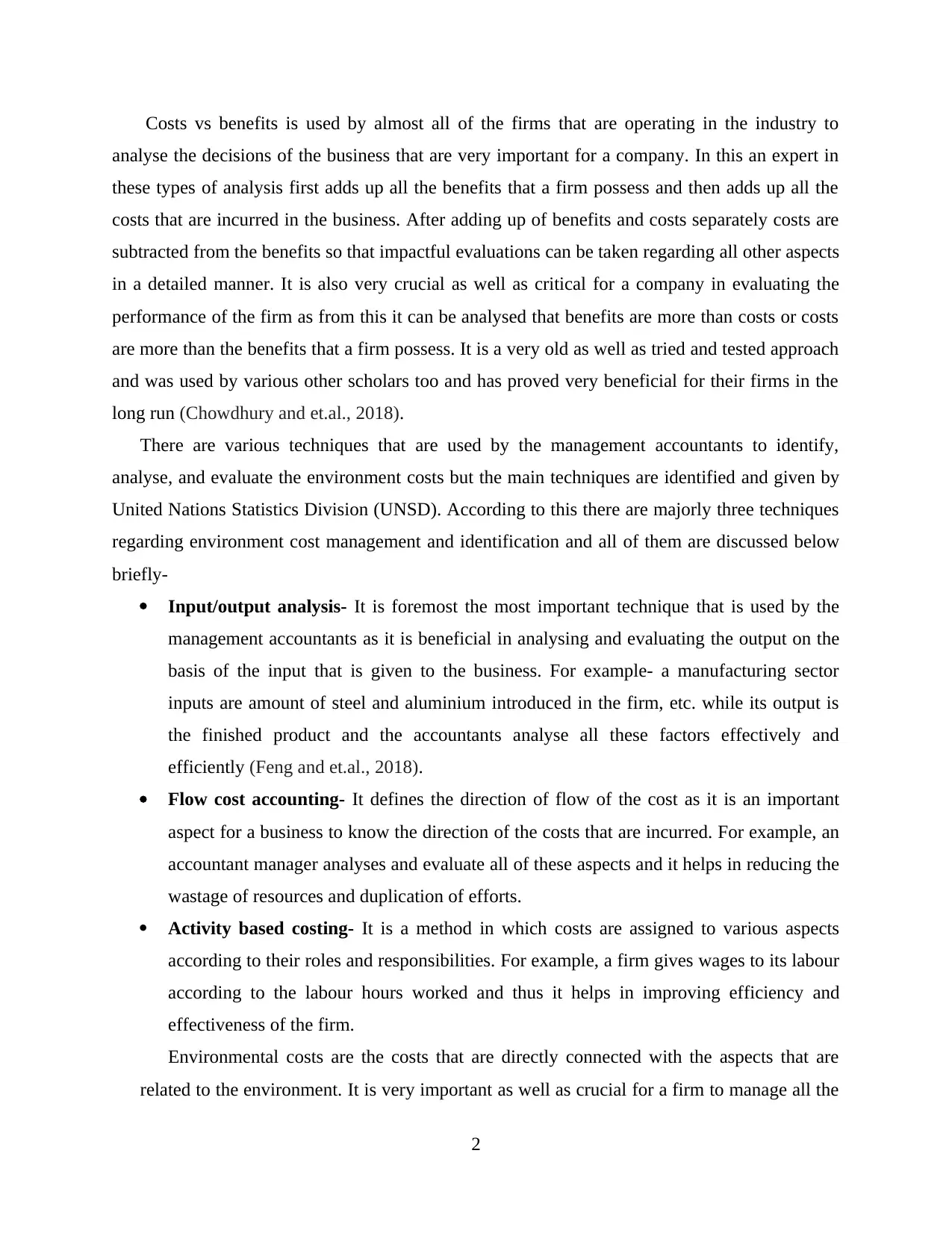
Costs vs benefits is used by almost all of the firms that are operating in the industry to
analyse the decisions of the business that are very important for a company. In this an expert in
these types of analysis first adds up all the benefits that a firm possess and then adds up all the
costs that are incurred in the business. After adding up of benefits and costs separately costs are
subtracted from the benefits so that impactful evaluations can be taken regarding all other aspects
in a detailed manner. It is also very crucial as well as critical for a company in evaluating the
performance of the firm as from this it can be analysed that benefits are more than costs or costs
are more than the benefits that a firm possess. It is a very old as well as tried and tested approach
and was used by various other scholars too and has proved very beneficial for their firms in the
long run (Chowdhury and et.al., 2018).
There are various techniques that are used by the management accountants to identify,
analyse, and evaluate the environment costs but the main techniques are identified and given by
United Nations Statistics Division (UNSD). According to this there are majorly three techniques
regarding environment cost management and identification and all of them are discussed below
briefly-
Input/output analysis- It is foremost the most important technique that is used by the
management accountants as it is beneficial in analysing and evaluating the output on the
basis of the input that is given to the business. For example- a manufacturing sector
inputs are amount of steel and aluminium introduced in the firm, etc. while its output is
the finished product and the accountants analyse all these factors effectively and
efficiently (Feng and et.al., 2018).
Flow cost accounting- It defines the direction of flow of the cost as it is an important
aspect for a business to know the direction of the costs that are incurred. For example, an
accountant manager analyses and evaluate all of these aspects and it helps in reducing the
wastage of resources and duplication of efforts.
Activity based costing- It is a method in which costs are assigned to various aspects
according to their roles and responsibilities. For example, a firm gives wages to its labour
according to the labour hours worked and thus it helps in improving efficiency and
effectiveness of the firm.
Environmental costs are the costs that are directly connected with the aspects that are
related to the environment. It is very important as well as crucial for a firm to manage all the
2
analyse the decisions of the business that are very important for a company. In this an expert in
these types of analysis first adds up all the benefits that a firm possess and then adds up all the
costs that are incurred in the business. After adding up of benefits and costs separately costs are
subtracted from the benefits so that impactful evaluations can be taken regarding all other aspects
in a detailed manner. It is also very crucial as well as critical for a company in evaluating the
performance of the firm as from this it can be analysed that benefits are more than costs or costs
are more than the benefits that a firm possess. It is a very old as well as tried and tested approach
and was used by various other scholars too and has proved very beneficial for their firms in the
long run (Chowdhury and et.al., 2018).
There are various techniques that are used by the management accountants to identify,
analyse, and evaluate the environment costs but the main techniques are identified and given by
United Nations Statistics Division (UNSD). According to this there are majorly three techniques
regarding environment cost management and identification and all of them are discussed below
briefly-
Input/output analysis- It is foremost the most important technique that is used by the
management accountants as it is beneficial in analysing and evaluating the output on the
basis of the input that is given to the business. For example- a manufacturing sector
inputs are amount of steel and aluminium introduced in the firm, etc. while its output is
the finished product and the accountants analyse all these factors effectively and
efficiently (Feng and et.al., 2018).
Flow cost accounting- It defines the direction of flow of the cost as it is an important
aspect for a business to know the direction of the costs that are incurred. For example, an
accountant manager analyses and evaluate all of these aspects and it helps in reducing the
wastage of resources and duplication of efforts.
Activity based costing- It is a method in which costs are assigned to various aspects
according to their roles and responsibilities. For example, a firm gives wages to its labour
according to the labour hours worked and thus it helps in improving efficiency and
effectiveness of the firm.
Environmental costs are the costs that are directly connected with the aspects that are
related to the environment. It is very important as well as crucial for a firm to manage all the
2
Paraphrase This Document
Need a fresh take? Get an instant paraphrase of this document with our AI Paraphraser
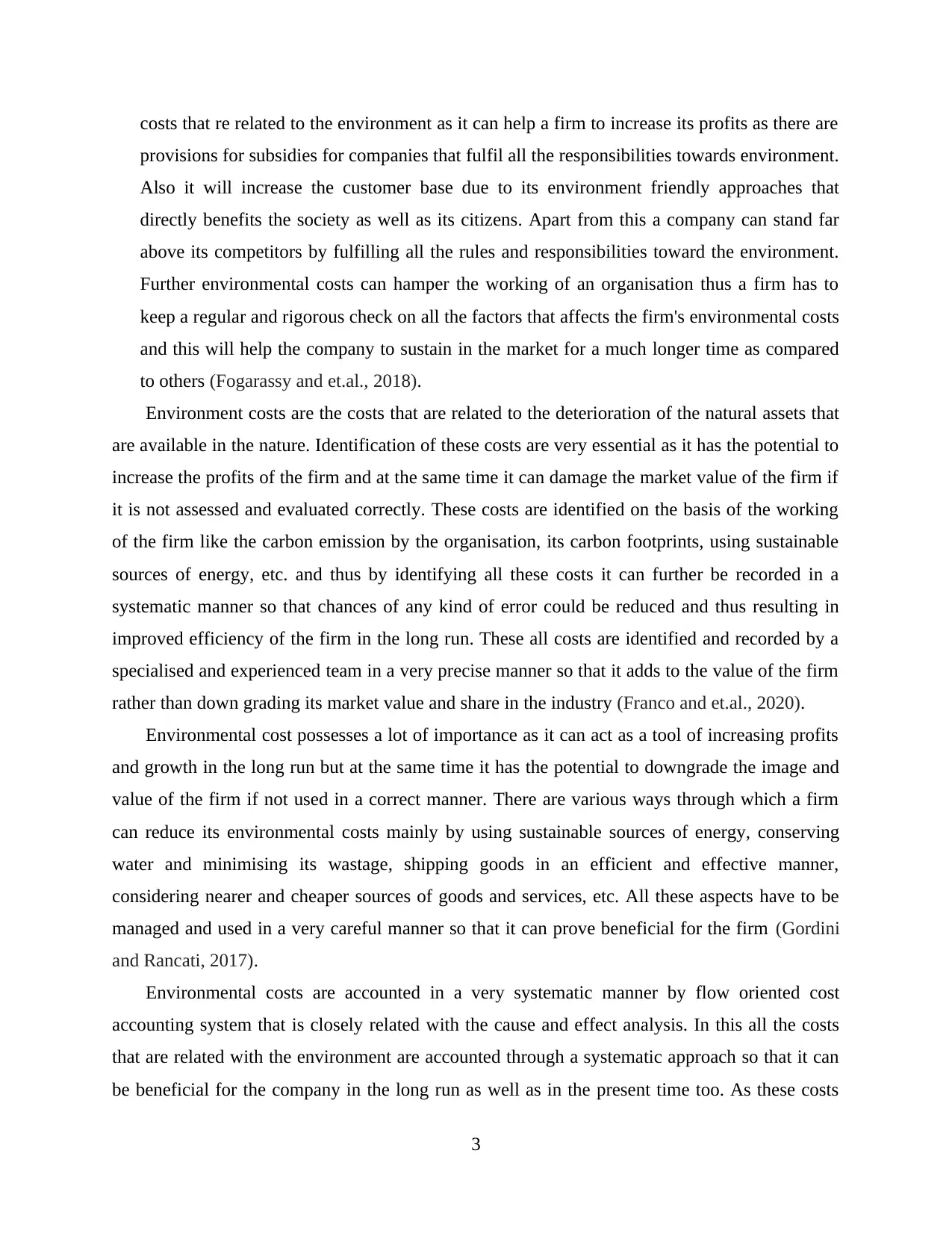
costs that re related to the environment as it can help a firm to increase its profits as there are
provisions for subsidies for companies that fulfil all the responsibilities towards environment.
Also it will increase the customer base due to its environment friendly approaches that
directly benefits the society as well as its citizens. Apart from this a company can stand far
above its competitors by fulfilling all the rules and responsibilities toward the environment.
Further environmental costs can hamper the working of an organisation thus a firm has to
keep a regular and rigorous check on all the factors that affects the firm's environmental costs
and this will help the company to sustain in the market for a much longer time as compared
to others (Fogarassy and et.al., 2018).
Environment costs are the costs that are related to the deterioration of the natural assets that
are available in the nature. Identification of these costs are very essential as it has the potential to
increase the profits of the firm and at the same time it can damage the market value of the firm if
it is not assessed and evaluated correctly. These costs are identified on the basis of the working
of the firm like the carbon emission by the organisation, its carbon footprints, using sustainable
sources of energy, etc. and thus by identifying all these costs it can further be recorded in a
systematic manner so that chances of any kind of error could be reduced and thus resulting in
improved efficiency of the firm in the long run. These all costs are identified and recorded by a
specialised and experienced team in a very precise manner so that it adds to the value of the firm
rather than down grading its market value and share in the industry (Franco and et.al., 2020).
Environmental cost possesses a lot of importance as it can act as a tool of increasing profits
and growth in the long run but at the same time it has the potential to downgrade the image and
value of the firm if not used in a correct manner. There are various ways through which a firm
can reduce its environmental costs mainly by using sustainable sources of energy, conserving
water and minimising its wastage, shipping goods in an efficient and effective manner,
considering nearer and cheaper sources of goods and services, etc. All these aspects have to be
managed and used in a very careful manner so that it can prove beneficial for the firm (Gordini
and Rancati, 2017).
Environmental costs are accounted in a very systematic manner by flow oriented cost
accounting system that is closely related with the cause and effect analysis. In this all the costs
that are related with the environment are accounted through a systematic approach so that it can
be beneficial for the company in the long run as well as in the present time too. As these costs
3
provisions for subsidies for companies that fulfil all the responsibilities towards environment.
Also it will increase the customer base due to its environment friendly approaches that
directly benefits the society as well as its citizens. Apart from this a company can stand far
above its competitors by fulfilling all the rules and responsibilities toward the environment.
Further environmental costs can hamper the working of an organisation thus a firm has to
keep a regular and rigorous check on all the factors that affects the firm's environmental costs
and this will help the company to sustain in the market for a much longer time as compared
to others (Fogarassy and et.al., 2018).
Environment costs are the costs that are related to the deterioration of the natural assets that
are available in the nature. Identification of these costs are very essential as it has the potential to
increase the profits of the firm and at the same time it can damage the market value of the firm if
it is not assessed and evaluated correctly. These costs are identified on the basis of the working
of the firm like the carbon emission by the organisation, its carbon footprints, using sustainable
sources of energy, etc. and thus by identifying all these costs it can further be recorded in a
systematic manner so that chances of any kind of error could be reduced and thus resulting in
improved efficiency of the firm in the long run. These all costs are identified and recorded by a
specialised and experienced team in a very precise manner so that it adds to the value of the firm
rather than down grading its market value and share in the industry (Franco and et.al., 2020).
Environmental cost possesses a lot of importance as it can act as a tool of increasing profits
and growth in the long run but at the same time it has the potential to downgrade the image and
value of the firm if not used in a correct manner. There are various ways through which a firm
can reduce its environmental costs mainly by using sustainable sources of energy, conserving
water and minimising its wastage, shipping goods in an efficient and effective manner,
considering nearer and cheaper sources of goods and services, etc. All these aspects have to be
managed and used in a very careful manner so that it can prove beneficial for the firm (Gordini
and Rancati, 2017).
Environmental costs are accounted in a very systematic manner by flow oriented cost
accounting system that is closely related with the cause and effect analysis. In this all the costs
that are related with the environment are accounted through a systematic approach so that it can
be beneficial for the company in the long run as well as in the present time too. As these costs
3
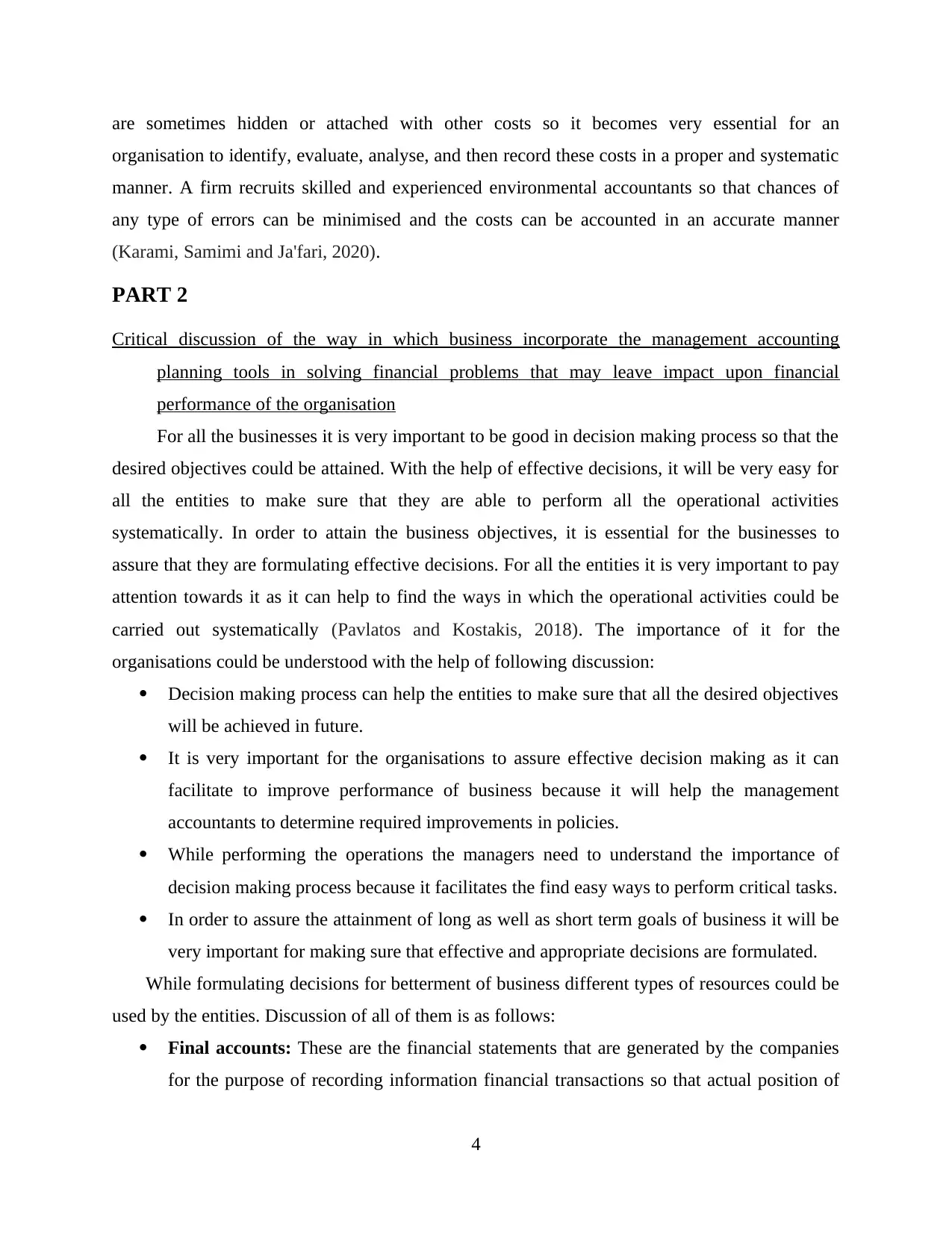
are sometimes hidden or attached with other costs so it becomes very essential for an
organisation to identify, evaluate, analyse, and then record these costs in a proper and systematic
manner. A firm recruits skilled and experienced environmental accountants so that chances of
any type of errors can be minimised and the costs can be accounted in an accurate manner
(Karami, Samimi and Ja'fari, 2020).
PART 2
Critical discussion of the way in which business incorporate the management accounting
planning tools in solving financial problems that may leave impact upon financial
performance of the organisation
For all the businesses it is very important to be good in decision making process so that the
desired objectives could be attained. With the help of effective decisions, it will be very easy for
all the entities to make sure that they are able to perform all the operational activities
systematically. In order to attain the business objectives, it is essential for the businesses to
assure that they are formulating effective decisions. For all the entities it is very important to pay
attention towards it as it can help to find the ways in which the operational activities could be
carried out systematically (Pavlatos and Kostakis, 2018). The importance of it for the
organisations could be understood with the help of following discussion:
Decision making process can help the entities to make sure that all the desired objectives
will be achieved in future.
It is very important for the organisations to assure effective decision making as it can
facilitate to improve performance of business because it will help the management
accountants to determine required improvements in policies.
While performing the operations the managers need to understand the importance of
decision making process because it facilitates the find easy ways to perform critical tasks.
In order to assure the attainment of long as well as short term goals of business it will be
very important for making sure that effective and appropriate decisions are formulated.
While formulating decisions for betterment of business different types of resources could be
used by the entities. Discussion of all of them is as follows:
Final accounts: These are the financial statements that are generated by the companies
for the purpose of recording information financial transactions so that actual position of
4
organisation to identify, evaluate, analyse, and then record these costs in a proper and systematic
manner. A firm recruits skilled and experienced environmental accountants so that chances of
any type of errors can be minimised and the costs can be accounted in an accurate manner
(Karami, Samimi and Ja'fari, 2020).
PART 2
Critical discussion of the way in which business incorporate the management accounting
planning tools in solving financial problems that may leave impact upon financial
performance of the organisation
For all the businesses it is very important to be good in decision making process so that the
desired objectives could be attained. With the help of effective decisions, it will be very easy for
all the entities to make sure that they are able to perform all the operational activities
systematically. In order to attain the business objectives, it is essential for the businesses to
assure that they are formulating effective decisions. For all the entities it is very important to pay
attention towards it as it can help to find the ways in which the operational activities could be
carried out systematically (Pavlatos and Kostakis, 2018). The importance of it for the
organisations could be understood with the help of following discussion:
Decision making process can help the entities to make sure that all the desired objectives
will be achieved in future.
It is very important for the organisations to assure effective decision making as it can
facilitate to improve performance of business because it will help the management
accountants to determine required improvements in policies.
While performing the operations the managers need to understand the importance of
decision making process because it facilitates the find easy ways to perform critical tasks.
In order to assure the attainment of long as well as short term goals of business it will be
very important for making sure that effective and appropriate decisions are formulated.
While formulating decisions for betterment of business different types of resources could be
used by the entities. Discussion of all of them is as follows:
Final accounts: These are the financial statements that are generated by the companies
for the purpose of recording information financial transactions so that actual position of
4
⊘ This is a preview!⊘
Do you want full access?
Subscribe today to unlock all pages.

Trusted by 1+ million students worldwide
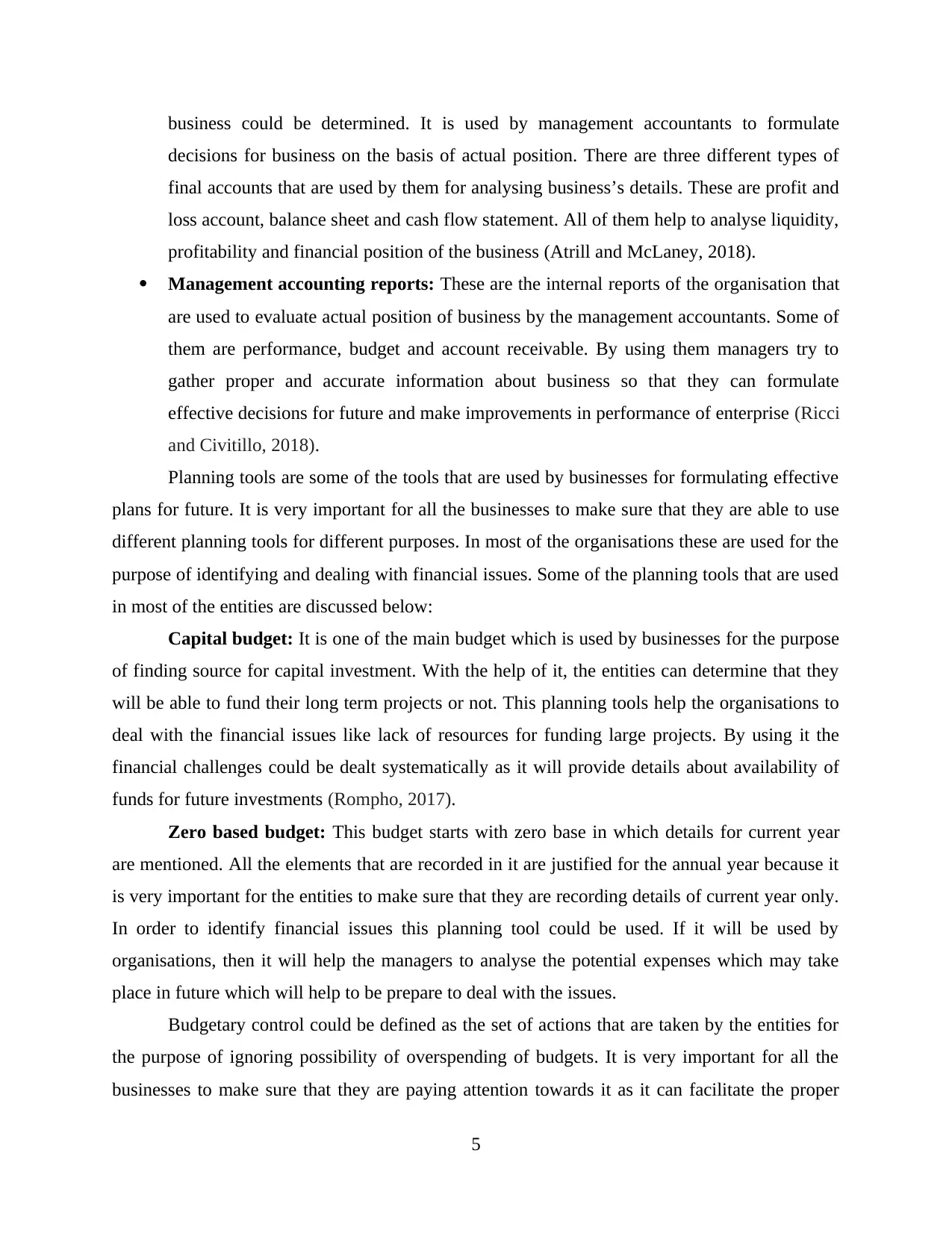
business could be determined. It is used by management accountants to formulate
decisions for business on the basis of actual position. There are three different types of
final accounts that are used by them for analysing business’s details. These are profit and
loss account, balance sheet and cash flow statement. All of them help to analyse liquidity,
profitability and financial position of the business (Atrill and McLaney, 2018).
Management accounting reports: These are the internal reports of the organisation that
are used to evaluate actual position of business by the management accountants. Some of
them are performance, budget and account receivable. By using them managers try to
gather proper and accurate information about business so that they can formulate
effective decisions for future and make improvements in performance of enterprise (Ricci
and Civitillo, 2018).
Planning tools are some of the tools that are used by businesses for formulating effective
plans for future. It is very important for all the businesses to make sure that they are able to use
different planning tools for different purposes. In most of the organisations these are used for the
purpose of identifying and dealing with financial issues. Some of the planning tools that are used
in most of the entities are discussed below:
Capital budget: It is one of the main budget which is used by businesses for the purpose
of finding source for capital investment. With the help of it, the entities can determine that they
will be able to fund their long term projects or not. This planning tools help the organisations to
deal with the financial issues like lack of resources for funding large projects. By using it the
financial challenges could be dealt systematically as it will provide details about availability of
funds for future investments (Rompho, 2017).
Zero based budget: This budget starts with zero base in which details for current year
are mentioned. All the elements that are recorded in it are justified for the annual year because it
is very important for the entities to make sure that they are recording details of current year only.
In order to identify financial issues this planning tool could be used. If it will be used by
organisations, then it will help the managers to analyse the potential expenses which may take
place in future which will help to be prepare to deal with the issues.
Budgetary control could be defined as the set of actions that are taken by the entities for
the purpose of ignoring possibility of overspending of budgets. It is very important for all the
businesses to make sure that they are paying attention towards it as it can facilitate the proper
5
decisions for business on the basis of actual position. There are three different types of
final accounts that are used by them for analysing business’s details. These are profit and
loss account, balance sheet and cash flow statement. All of them help to analyse liquidity,
profitability and financial position of the business (Atrill and McLaney, 2018).
Management accounting reports: These are the internal reports of the organisation that
are used to evaluate actual position of business by the management accountants. Some of
them are performance, budget and account receivable. By using them managers try to
gather proper and accurate information about business so that they can formulate
effective decisions for future and make improvements in performance of enterprise (Ricci
and Civitillo, 2018).
Planning tools are some of the tools that are used by businesses for formulating effective
plans for future. It is very important for all the businesses to make sure that they are able to use
different planning tools for different purposes. In most of the organisations these are used for the
purpose of identifying and dealing with financial issues. Some of the planning tools that are used
in most of the entities are discussed below:
Capital budget: It is one of the main budget which is used by businesses for the purpose
of finding source for capital investment. With the help of it, the entities can determine that they
will be able to fund their long term projects or not. This planning tools help the organisations to
deal with the financial issues like lack of resources for funding large projects. By using it the
financial challenges could be dealt systematically as it will provide details about availability of
funds for future investments (Rompho, 2017).
Zero based budget: This budget starts with zero base in which details for current year
are mentioned. All the elements that are recorded in it are justified for the annual year because it
is very important for the entities to make sure that they are recording details of current year only.
In order to identify financial issues this planning tool could be used. If it will be used by
organisations, then it will help the managers to analyse the potential expenses which may take
place in future which will help to be prepare to deal with the issues.
Budgetary control could be defined as the set of actions that are taken by the entities for
the purpose of ignoring possibility of overspending of budgets. It is very important for all the
businesses to make sure that they are paying attention towards it as it can facilitate the proper
5
Paraphrase This Document
Need a fresh take? Get an instant paraphrase of this document with our AI Paraphraser
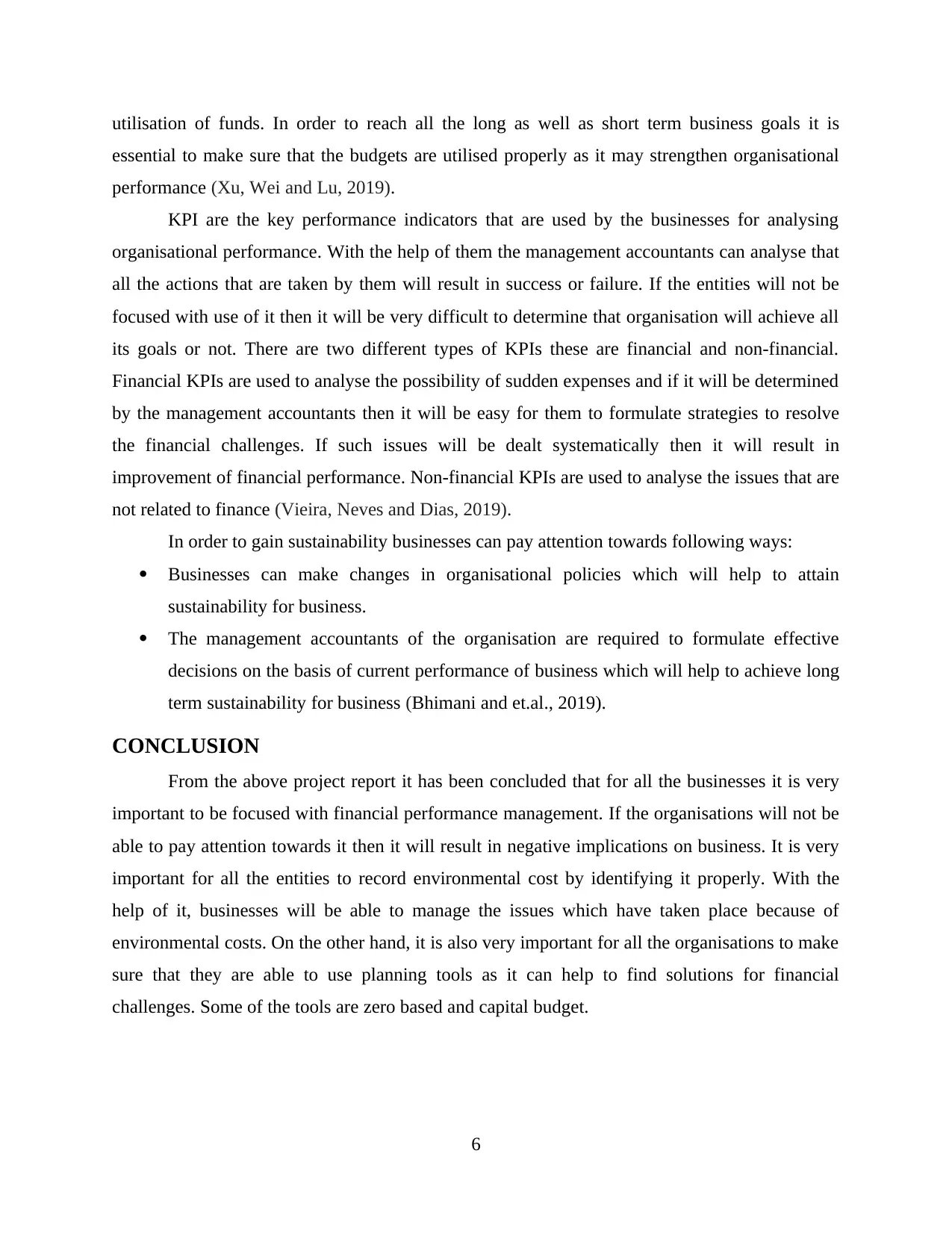
utilisation of funds. In order to reach all the long as well as short term business goals it is
essential to make sure that the budgets are utilised properly as it may strengthen organisational
performance (Xu, Wei and Lu, 2019).
KPI are the key performance indicators that are used by the businesses for analysing
organisational performance. With the help of them the management accountants can analyse that
all the actions that are taken by them will result in success or failure. If the entities will not be
focused with use of it then it will be very difficult to determine that organisation will achieve all
its goals or not. There are two different types of KPIs these are financial and non-financial.
Financial KPIs are used to analyse the possibility of sudden expenses and if it will be determined
by the management accountants then it will be easy for them to formulate strategies to resolve
the financial challenges. If such issues will be dealt systematically then it will result in
improvement of financial performance. Non-financial KPIs are used to analyse the issues that are
not related to finance (Vieira, Neves and Dias, 2019).
In order to gain sustainability businesses can pay attention towards following ways:
Businesses can make changes in organisational policies which will help to attain
sustainability for business.
The management accountants of the organisation are required to formulate effective
decisions on the basis of current performance of business which will help to achieve long
term sustainability for business (Bhimani and et.al., 2019).
CONCLUSION
From the above project report it has been concluded that for all the businesses it is very
important to be focused with financial performance management. If the organisations will not be
able to pay attention towards it then it will result in negative implications on business. It is very
important for all the entities to record environmental cost by identifying it properly. With the
help of it, businesses will be able to manage the issues which have taken place because of
environmental costs. On the other hand, it is also very important for all the organisations to make
sure that they are able to use planning tools as it can help to find solutions for financial
challenges. Some of the tools are zero based and capital budget.
6
essential to make sure that the budgets are utilised properly as it may strengthen organisational
performance (Xu, Wei and Lu, 2019).
KPI are the key performance indicators that are used by the businesses for analysing
organisational performance. With the help of them the management accountants can analyse that
all the actions that are taken by them will result in success or failure. If the entities will not be
focused with use of it then it will be very difficult to determine that organisation will achieve all
its goals or not. There are two different types of KPIs these are financial and non-financial.
Financial KPIs are used to analyse the possibility of sudden expenses and if it will be determined
by the management accountants then it will be easy for them to formulate strategies to resolve
the financial challenges. If such issues will be dealt systematically then it will result in
improvement of financial performance. Non-financial KPIs are used to analyse the issues that are
not related to finance (Vieira, Neves and Dias, 2019).
In order to gain sustainability businesses can pay attention towards following ways:
Businesses can make changes in organisational policies which will help to attain
sustainability for business.
The management accountants of the organisation are required to formulate effective
decisions on the basis of current performance of business which will help to achieve long
term sustainability for business (Bhimani and et.al., 2019).
CONCLUSION
From the above project report it has been concluded that for all the businesses it is very
important to be focused with financial performance management. If the organisations will not be
able to pay attention towards it then it will result in negative implications on business. It is very
important for all the entities to record environmental cost by identifying it properly. With the
help of it, businesses will be able to manage the issues which have taken place because of
environmental costs. On the other hand, it is also very important for all the organisations to make
sure that they are able to use planning tools as it can help to find solutions for financial
challenges. Some of the tools are zero based and capital budget.
6
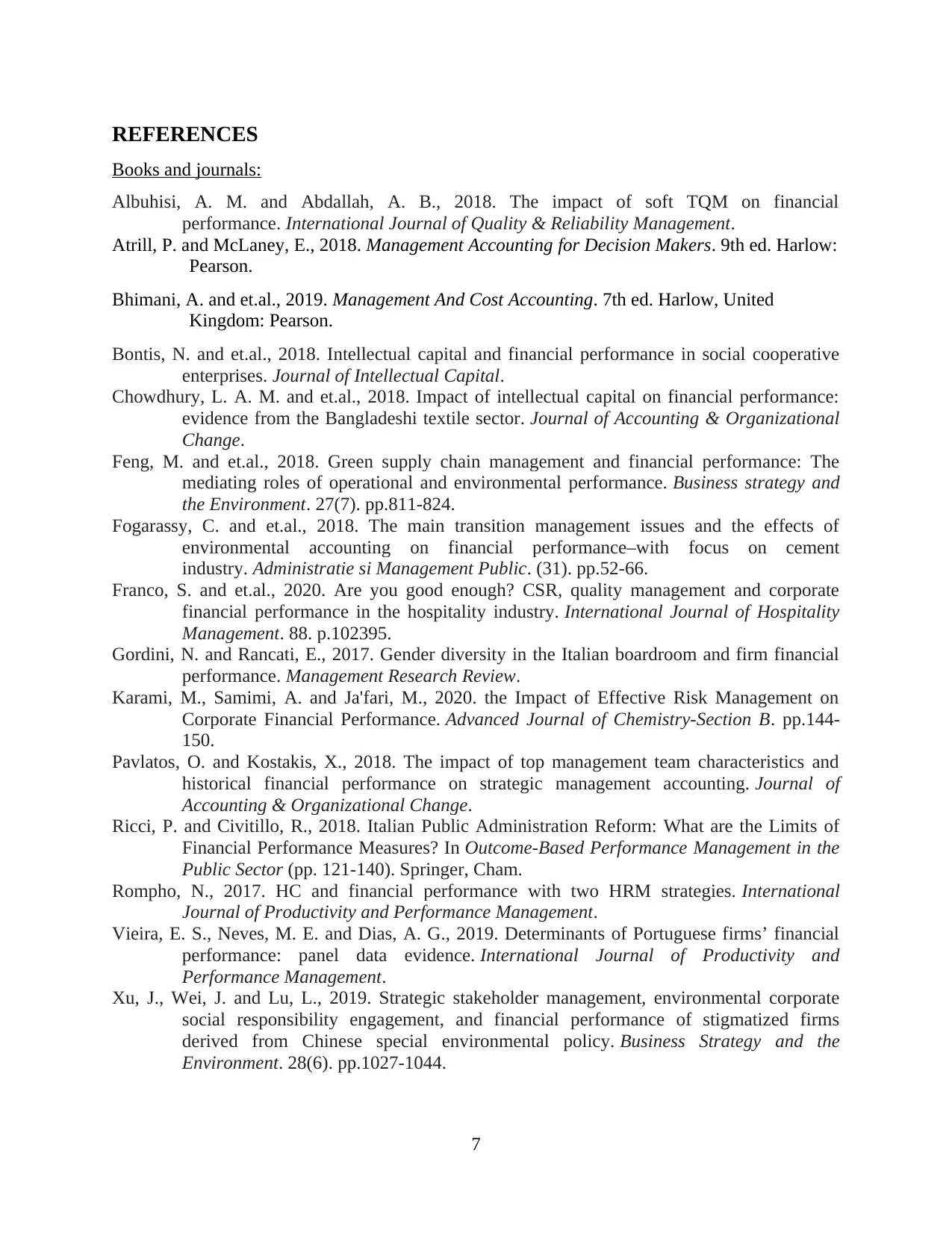
REFERENCES
Books and journals:
Albuhisi, A. M. and Abdallah, A. B., 2018. The impact of soft TQM on financial
performance. International Journal of Quality & Reliability Management.
Atrill, P. and McLaney, E., 2018. Management Accounting for Decision Makers. 9th ed. Harlow:
Pearson.
Bhimani, A. and et.al., 2019. Management And Cost Accounting. 7th ed. Harlow, United
Kingdom: Pearson.
Bontis, N. and et.al., 2018. Intellectual capital and financial performance in social cooperative
enterprises. Journal of Intellectual Capital.
Chowdhury, L. A. M. and et.al., 2018. Impact of intellectual capital on financial performance:
evidence from the Bangladeshi textile sector. Journal of Accounting & Organizational
Change.
Feng, M. and et.al., 2018. Green supply chain management and financial performance: The
mediating roles of operational and environmental performance. Business strategy and
the Environment. 27(7). pp.811-824.
Fogarassy, C. and et.al., 2018. The main transition management issues and the effects of
environmental accounting on financial performance–with focus on cement
industry. Administratie si Management Public. (31). pp.52-66.
Franco, S. and et.al., 2020. Are you good enough? CSR, quality management and corporate
financial performance in the hospitality industry. International Journal of Hospitality
Management. 88. p.102395.
Gordini, N. and Rancati, E., 2017. Gender diversity in the Italian boardroom and firm financial
performance. Management Research Review.
Karami, M., Samimi, A. and Ja'fari, M., 2020. the Impact of Effective Risk Management on
Corporate Financial Performance. Advanced Journal of Chemistry-Section B. pp.144-
150.
Pavlatos, O. and Kostakis, X., 2018. The impact of top management team characteristics and
historical financial performance on strategic management accounting. Journal of
Accounting & Organizational Change.
Ricci, P. and Civitillo, R., 2018. Italian Public Administration Reform: What are the Limits of
Financial Performance Measures? In Outcome-Based Performance Management in the
Public Sector (pp. 121-140). Springer, Cham.
Rompho, N., 2017. HC and financial performance with two HRM strategies. International
Journal of Productivity and Performance Management.
Vieira, E. S., Neves, M. E. and Dias, A. G., 2019. Determinants of Portuguese firms’ financial
performance: panel data evidence. International Journal of Productivity and
Performance Management.
Xu, J., Wei, J. and Lu, L., 2019. Strategic stakeholder management, environmental corporate
social responsibility engagement, and financial performance of stigmatized firms
derived from Chinese special environmental policy. Business Strategy and the
Environment. 28(6). pp.1027-1044.
7
Books and journals:
Albuhisi, A. M. and Abdallah, A. B., 2018. The impact of soft TQM on financial
performance. International Journal of Quality & Reliability Management.
Atrill, P. and McLaney, E., 2018. Management Accounting for Decision Makers. 9th ed. Harlow:
Pearson.
Bhimani, A. and et.al., 2019. Management And Cost Accounting. 7th ed. Harlow, United
Kingdom: Pearson.
Bontis, N. and et.al., 2018. Intellectual capital and financial performance in social cooperative
enterprises. Journal of Intellectual Capital.
Chowdhury, L. A. M. and et.al., 2018. Impact of intellectual capital on financial performance:
evidence from the Bangladeshi textile sector. Journal of Accounting & Organizational
Change.
Feng, M. and et.al., 2018. Green supply chain management and financial performance: The
mediating roles of operational and environmental performance. Business strategy and
the Environment. 27(7). pp.811-824.
Fogarassy, C. and et.al., 2018. The main transition management issues and the effects of
environmental accounting on financial performance–with focus on cement
industry. Administratie si Management Public. (31). pp.52-66.
Franco, S. and et.al., 2020. Are you good enough? CSR, quality management and corporate
financial performance in the hospitality industry. International Journal of Hospitality
Management. 88. p.102395.
Gordini, N. and Rancati, E., 2017. Gender diversity in the Italian boardroom and firm financial
performance. Management Research Review.
Karami, M., Samimi, A. and Ja'fari, M., 2020. the Impact of Effective Risk Management on
Corporate Financial Performance. Advanced Journal of Chemistry-Section B. pp.144-
150.
Pavlatos, O. and Kostakis, X., 2018. The impact of top management team characteristics and
historical financial performance on strategic management accounting. Journal of
Accounting & Organizational Change.
Ricci, P. and Civitillo, R., 2018. Italian Public Administration Reform: What are the Limits of
Financial Performance Measures? In Outcome-Based Performance Management in the
Public Sector (pp. 121-140). Springer, Cham.
Rompho, N., 2017. HC and financial performance with two HRM strategies. International
Journal of Productivity and Performance Management.
Vieira, E. S., Neves, M. E. and Dias, A. G., 2019. Determinants of Portuguese firms’ financial
performance: panel data evidence. International Journal of Productivity and
Performance Management.
Xu, J., Wei, J. and Lu, L., 2019. Strategic stakeholder management, environmental corporate
social responsibility engagement, and financial performance of stigmatized firms
derived from Chinese special environmental policy. Business Strategy and the
Environment. 28(6). pp.1027-1044.
7
⊘ This is a preview!⊘
Do you want full access?
Subscribe today to unlock all pages.

Trusted by 1+ million students worldwide
1 out of 9
Related Documents
Your All-in-One AI-Powered Toolkit for Academic Success.
+13062052269
info@desklib.com
Available 24*7 on WhatsApp / Email
![[object Object]](/_next/static/media/star-bottom.7253800d.svg)
Unlock your academic potential
Copyright © 2020–2025 A2Z Services. All Rights Reserved. Developed and managed by ZUCOL.





